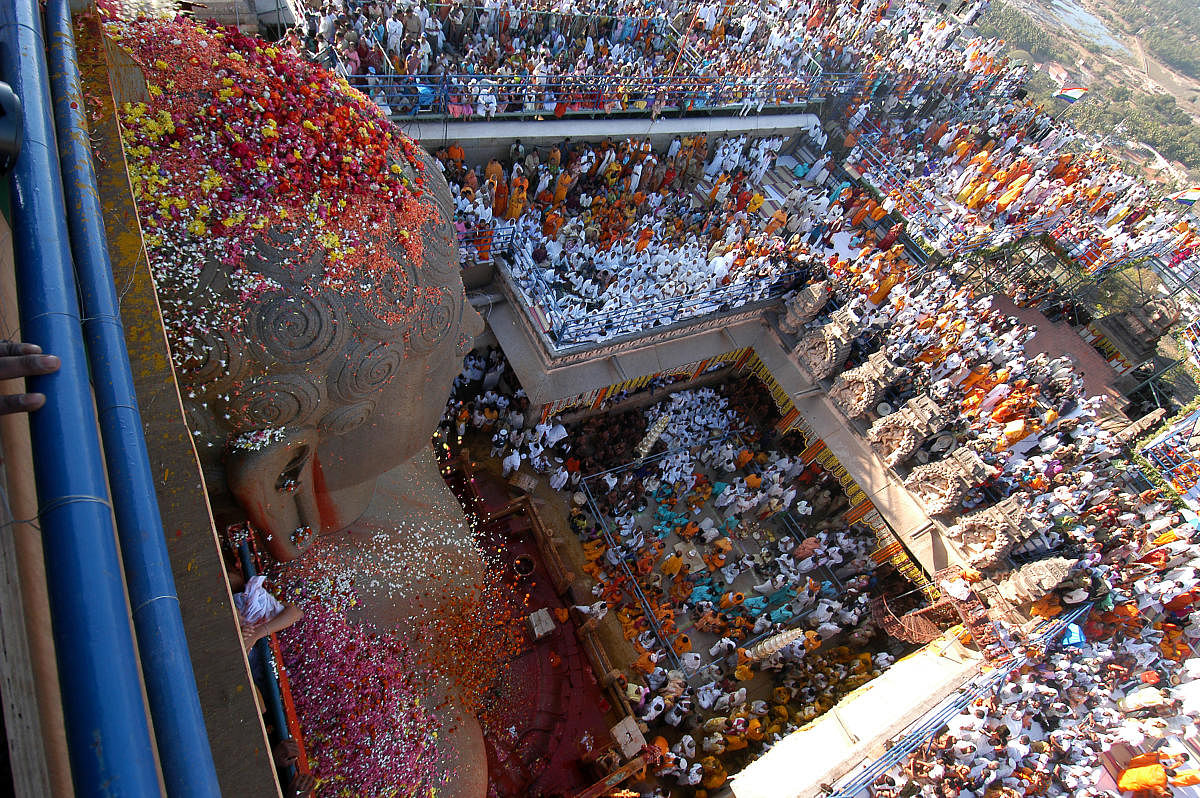
Hordes of pilgrims and devotees are flocking to the summit of a rocky hill, the higher one of two hills adjoining a small town in Hassan district, called Shravanabelagola. There, within a walled compound, over a period of nine days from February 17-25, they will witness the anointing of the tallest freestanding granite monolith in the world - an image of the Jain renunciate Gommateshwara, in a ritual of exuberant celebration. Tradition maintains that the first ever such ceremony was performed on the consecration of the 57-feet tall colossus, in 981 CE, presided over by the Jain gurus Ajitasena and Nemichandra, in the presence of the Ganga King Rachamalla and his illustrious minister Chavundaraya.
As per legendary accounts, the minister, who was instrumental in the carving of the monolith, wished to consecrate the image by bathing it with five fluids, called panchamruta. But despite pouring copious amounts of unguents over the image, he was unable to bathe it from head to toe. At this juncture, a poor old woman put in an appearance, holding a gourd containing milk, and wished to pour the contents on the colossal image. More to humour her, Chavundaraya escorted the ajji onto the scaffolding, whereupon she amazed all by anointing the entire image with the milk from her tiny vessel. This tale, which cautions against taking undue pride in one's achievements, however big, is probably the origin of the practice of Mahamastakabhisheka. Currently, this awe-inspiring spectacle of the gigantic image being bathed in holy water, milk, sandalwood paste and other unguents, is conducted once every 12 years.
Monuments & memorials
The town of Shravanabelagola nestles at the feet of the two rocky hills, known as Vindhyagiri (Indragiri) and Chandragiri or just Dodda Betta (Big Hill) and Chikka Betta (Small Hill). If any among the multitudes thronging this important religious centre of the Jains return after just witnessing the Mahamastakabhisheka and hurriedly surveying some of the prominent monuments on the bigger hill, they would be missing much that the smaller hill has to offer.
Legend informs us that the history of this place stretches back to the third century BCE, when the Mauryan Emperor Chandragupta Maurya arrived here, along with his preceptor, Srutakevali Bhadrabahu. Srutakevalis were the second line of successors of the tirthankaras. Chandragupta, who had abdicated his throne and embraced Jainism, accompanied Bhadrabahu to the small hill at Belagola, where it is believed that the master and the disciple embraced death by ritual fasting.
It is in honour of the former emperor that the small hill is called Chandragiri in popular tradition. However, the hill is referred to as Katavapra and Kalbappu, in Sanskrit and Kannada respectively, in several inscriptions extant at Shravanabelagola. The precise meaning of this name is unclear, but renowned scholar Prof S Settar, whose masterful study of Shravanabelagola is outlined in three books and numerous articles, favours the meaning 'Sepulchral Hill'.
The recorded history of Shravanabelagola begins with an inscription dated to 600 CE, which describes the ritual death of a monk named Prabhachandra. Prof Settar believes that the earliest practitioners of ritual death did not leave behind any records of their penance. In his book Inviting Death, Prof Settar examines the inscriptional record and traces the evolution of this commemorative practice from mere inscriptions on rocks to carving of the imprints of feet and erection of structures like memorial pillars, pavilions and temples.
A pair of carved footprints on the floor of the cave, where Bhadrabahu is believed to have lived out his final days, commemorate the srutakevali. The Chandragupta Basadi was erected much later, in the ninth century. The most impressive structure on the hill, however, is the Chavundaraya Basadi. Elegant manasthambhas contribute to the variety of structures on the hill.
Vindhyagiri, which comes into the picture late in the tenth century, when Chavundaraya had the Gommata image carved, has its share of monuments, memorials and inscriptions. The first large structure one encounters upon finishing the long climb up the hillside is the Odegal Basadi. It is a trikuta structure enshrining Rishabhanatha, the first Tirthankara and father of Bahubali; as well as Neminatha and Shantinatha. The Tyagada Kamba marks the spot where Chavundaraya distributed gifts, according to local legend. The Akhanda Bagilu, beside a large boulder embellished with memorials called the Siddhara Gundu, is a portal leading to the walled compound surrounding the Gommata statue.
The bustling town that is Shravanabelagola today is a far cry from what it must have been at the beginning of its history. From the top of Indragiri, Gommata smiles beatifically, spreading his blessings over the land for over a millennium. The monuments of several dynasties dot the hills, and the township, symbols of the patronage bestowed upon the Jain faith. And Shravanabelagola continues to summon the faithful from all over, as it has been doing for more than two thousand years.